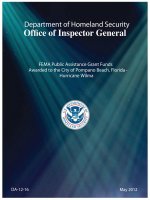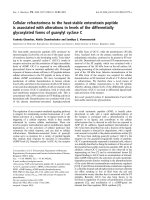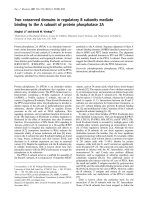Retrovirology This Provisional PDF corresponds to the article as it appeared upon acceptance. Fully docx
Bạn đang xem bản rút gọn của tài liệu. Xem và tải ngay bản đầy đủ của tài liệu tại đây (346.98 KB, 5 trang )
This Provisional PDF corresponds to the article as it appeared upon acceptance. Fully formatted
PDF and full text (HTML) versions will be made available soon.
Equal versus equivalent access to the scientific literature
Retrovirology 2011, 8:83 doi:10.1186/1742-4690-8-83
Kuan-Teh Jeang ()
ISSN 1742-4690
Article type Editorial
Submission date 16 October 2011
Acceptance date 21 October 2011
Publication date 21 October 2011
Article URL />This peer-reviewed article was published immediately upon acceptance. It can be downloaded,
printed and distributed freely for any purposes (see copyright notice below).
Articles in Retrovirology are listed in PubMed and archived at PubMed Central.
For information about publishing your research in Retrovirology or any BioMed Central journal, go to
/>For information about other BioMed Central publications go to
/>Retrovirology
© 2011 Jeang ; licensee BioMed Central Ltd.
This is an open access article distributed under the terms of the Creative Commons Attribution License ( />which permits unrestricted use, distribution, and reproduction in any medium, provided the original work is properly cited.
Editorial
Equal versus equivalent access to the scientific literature
Kuan-Teh Jeang
The National Institutes of Health, Bethesda, MD, USA
Email:
Abstract
The concepts of equal versus equivalent access to the scientific literature are
discussed.
In 1954, the United States Supreme Court in a landmark decision of Brown vs. Board of
Education of Topeka, Kansas sharply repudiated the “separate but equal” principle of
public education. The Court concluded that racially segregated education is “inherently
unequal”. In scientific publishing today, there exist two segregated means of knowledge
dissemination the subscription journals and the Open Access (OA) journals. For those
who can pay, there is immediate access to scientific papers published in both subscription
and OA journals; those who cannot pay can access only OA journals. The status quo is
thus an “inherently unequal” playing field between the “haves” and the “have nots”.
How unequal is the current situation? In an August 1, 2011 posting on the Nature News
website, Richard Van Noorden reported that “the proportion of research papers freely
available is slowly and steadily creeping upwards… in 2009, it’s above 28%. (Some of
this literature is not immediately available at the time that it is published, because of
journal policies that impose embargo periods on when material can become free)”. The
good news is that approximately 30% of published papers can be accessed freely. The
bad news is that 70% of published, publicly funded research remains off-limits to those
who cannot pay.
Can equal access be had by the “haves” and the “have nots”? To the extent that the
subscription and OA tracks will likely co-exist, the foreseeable future is a “separate and
unequal” reality. Without equal access, the next best goal is perhaps to achieve
equivalent access.
What is equivalent access? Imagine two very similar papers reaching essentially the
same conclusions; one is published in a subscription journal and the other published in an
OA journal. The paying reader can read both papers; the non-paying person can read
only the OA paper. This is “unequal” access. However, if the OA paper sufficiently
conveys the same information as the subscription paper, then it is possible that
“equivalent” knowledge is conveyed to both the can-pay and cannot-pay audiences.
2
The equivalent access concept works only if subscription and OA journals can attract and
publish, in chronological proximity, similar articles of comparable quality and impact.
Practically speaking, for this to occur, OA journals need to achieve quality metrics (e.g.
Impact Factor numbers) that match their subscription counterparts. The Retrovirology
experience suggests that such benchmark can be achieved (Figure 1).
Achieving qualitative parity will go a long way towards advancing equivalent access to
important biological findings. One could raise the recent XMRV-Chronic Fatigue
Syndrome controversy [1] as an example. A strongly credible case can be made that OA
readers who read only Retrovirology papers [2-9] knowledgeably reached the equivalent
scientific conclusion regarding this topic as those who read the subscription-based
literature.
The quality of OA publishing will continue to improve. In 2012, Cell will launch a top
tier OA publication, Cell Reports; and the Wellcome Trust/ the Howard Hughes Medical
Institute/ the Max Planck Society will also start a similarly high profile OA journal.
Because intelligence and ambition are distributed equally around the globe [10], freely
available equivalent access to timely knowledge matters. “Separate but equivalent” may
become the watchword of 21
st
century publishing.
Acknowledgements
The opinions expressed are the author’s personal views and do not necessarily reflect
those of his employer, the National Institutes of Health (NIH). Work in KTJ’s laboratory
is supported in part by intramural funding from the National Institute of Allergy and
Infectious Diseases (NIAID). The author thanks Mark Wainberg, Ben Berkhout, Yun-Bo
Shi, Deborah Kahn, and Michaela Torkar for critical readings of this editorial.
Reference List
1. Wainberg MA, Jeang KT: XMRV as a human pathogen? Cell Host Microbe 2011,
9: 260-262.
2. Garson JA, Kellam P, Towers GJ: Analysis of XMRV integration sites from
human prostate cancer tissues suggests PCR contamination rather than
genuine human infection. Retrovirology 2011, 8: 13.
3. Hue S, Gray ER, Gall A, Katzourakis A, Tan CP, Houldcroft CJ et al.: Disease-
associated XMRV sequences are consistent with laboratory contamination.
Retrovirology 2010, 7: 111.
4. Switzer WM, Jia H, Hohn O, Zheng H, Tang S, Shankar A et al.: Absence of
evidence of xenotropic murine leukemia virus-related virus infection in
3
persons with chronic fatigue syndrome and healthy controls in the United
States. Retrovirology 2010, 7: 57.
5. Sato E, Furuta RA, Miyazawa T: An endogenous murine leukemia viral genome
contaminant in a commercial RT-PCR kit is amplified using standard primers
for XMRV. Retrovirology 2010, 7: 110.
6. Groom HC, Boucherit VC, Makinson K, Randal E, Baptista S, Hagan S et al.:
Absence of xenotropic murine leukaemia virus-related virus in UK patients
with chronic fatigue syndrome. Retrovirology 2010, 7: 10.
7. Smith RA: Contamination of clinical specimens with MLV-encoding nucleic
acids: implications for XMRV and other candidate human retroviruses.
Retrovirology 2010, 7: 112.
8. Robinson MJ, Erlwein OW, Kaye S, Weber J, Cingoz O, Patel A et al.: Mouse
DNA contamination in human tissue tested for XMRV. Retrovirology 2010, 7:
108.
9. Oakes B, Tai AK, Cingoz O, Henefield MH, Levine S, Coffin JM et al.:
Contamination of human DNA samples with mouse DNA can lead to false
detection of XMRV-like sequences. Retrovirology 2010, 7: 109.
10. Jeang KT: Intelligence and ambition are distributed equally around the globe.
Retrovirology 2010, 7: 67.
Figure legend
Figure 1. Impact factor numbers from 2010 ISI-Thomson Reuters data that compare
Retrovirology with nine other subscription journals. Seven of the nine journals
publish basic virological research papers. The Journal of Biological Chemistry and
the Journal of Molecular Biology are included for comparison to two well-
established journals that publish basic research papers in biochemistry and
molecular biology.
Figure 1









